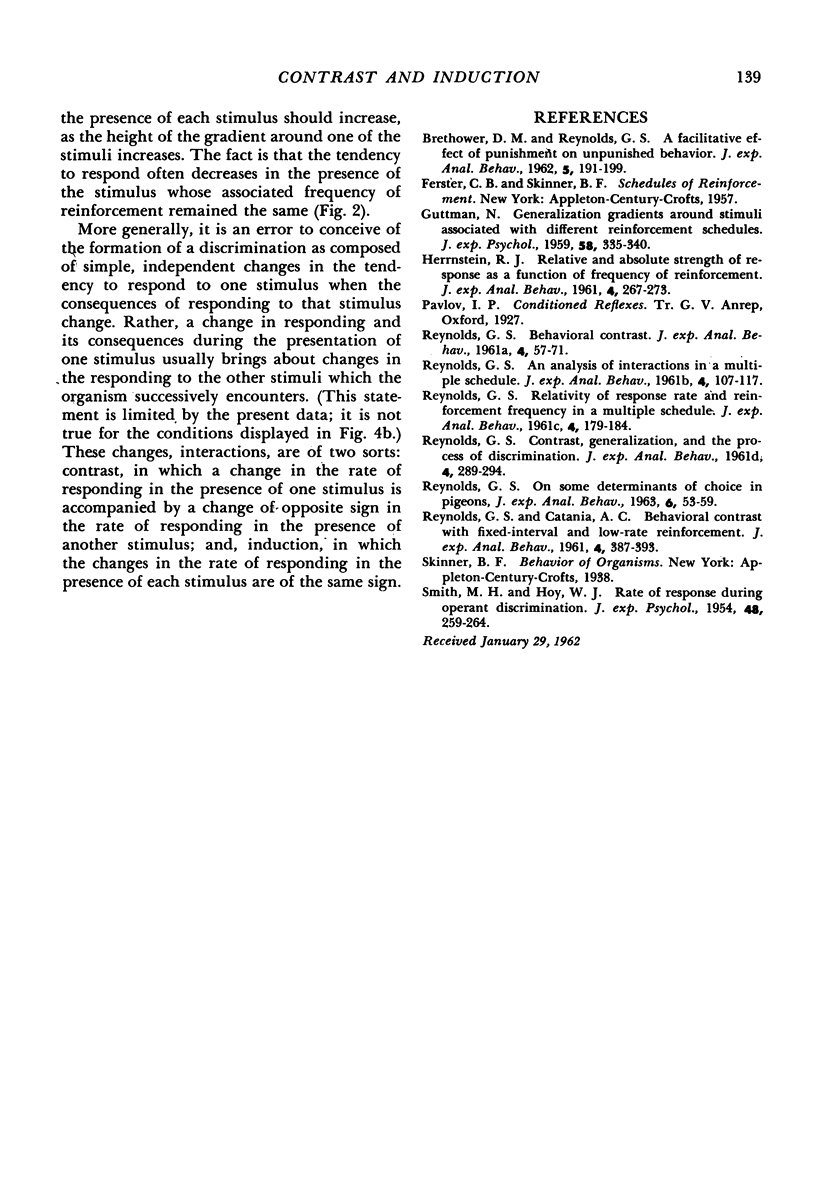Abstract
A pigeon's rate of pecking on a red key, reinforced at a constant frequency, may be changed by increasing or decreasing the frequency of reinforcement of pecking on a successively presented green key. The changes in the rate of pecking on red, called interactions, are of two types: contrast, in which the changes in the rates of pecking on the two colors are in opposite directions; and, induction, in which the changes in the rates are in the same direction. In previous data, a change in the frequency of reinforcement associated with the green key produced a corresponding change in the rate of pecking the green key and an opposite change (contrast) in the rate of pecking on the red key. The present data suggest that the magnitude of contrast is very small if pecking on the red key is reinforced at a high enough frequency (about 40 reinforcements per hr in the present experiment). Also, given that interactions occur, induction rather than contrast may result from small changes in a low frequency of reinforcement associated with green.
Full text
PDF








Selected References
These references are in PubMed. This may not be the complete list of references from this article.
- BRETHOWER D. M., REYNOLDS G. S. A facilitative effect of punishment on unpunished behavior. J Exp Anal Behav. 1962 Apr;5:191–199. doi: 10.1901/jeab.1962.5-191. [DOI] [PMC free article] [PubMed] [Google Scholar]
- GUTTMAN N. Generalization gradients around stimuli associated with different reinforcement schedules. J Exp Psychol. 1959 Nov;58:335–340. doi: 10.1037/h0045679. [DOI] [PubMed] [Google Scholar]
- HERRNSTEIN R. J. Relative and absolute strength of response as a function of frequency of reinforcement. J Exp Anal Behav. 1961 Jul;4:267–272. doi: 10.1901/jeab.1961.4-267. [DOI] [PMC free article] [PubMed] [Google Scholar]
- REYNOLDS G. S. Behavioral contrast. J Exp Anal Behav. 1961 Jan;4:57–71. doi: 10.1901/jeab.1961.4-57. [DOI] [PMC free article] [PubMed] [Google Scholar]
- REYNOLDS G. S., CATANIA A. C. Behavioral contrast with fixed interval and low-rate reinforcement. J Exp Anal Behav. 1961 Oct;4:387–391. doi: 10.1901/jeab.1961.4-387. [DOI] [PMC free article] [PubMed] [Google Scholar]
- REYNOLDS G. S. Relativity of response rate and reinforcement frequency in a multiple schedule. J Exp Anal Behav. 1961 Apr;4:179–184. doi: 10.1901/jeab.1961.4-179. [DOI] [PMC free article] [PubMed] [Google Scholar]
- Reynolds G. S. An analysis of interactions in a multiple schedule. J Exp Anal Behav. 1961 Apr;4(2):107–117. doi: 10.1901/jeab.1961.4-107. [DOI] [PMC free article] [PubMed] [Google Scholar]
- SMITH M. H., Jr, HOY W. J. Rate of response during operant discrimination. J Exp Psychol. 1954 Oct;48(4):259–264. doi: 10.1037/h0056928. [DOI] [PubMed] [Google Scholar]


